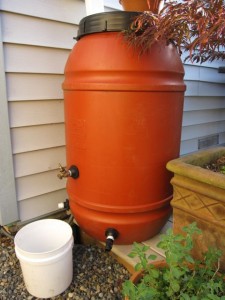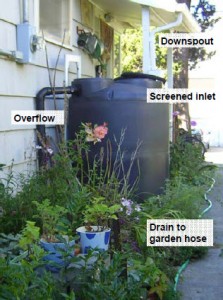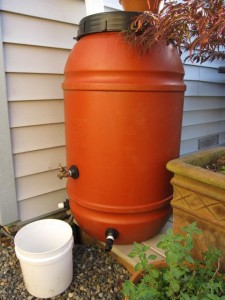Common questions about using rain barrels in the Seattle area
August 17, 2012 @ 10:30 am

Rain barrel. Photo by Ecoyards.
We’ve been enjoying unusually warm, dry and sunny weather in Seattle lately. The lack of rain means it’s a great time to tap your rain barrels to water your plants. Most of you know that rain barrels are used to catch rain water and store it for later use. We get a lot of questions about rain barrels from customers, so we’ve tackled a couple of them here.
Can I use my rain barrel water for vegetables? Unless you get your water tested, there’s really no way to know for certain whether the water that runs off your rooftop and into gutters and then your rain barrel is completely safe for edible plants. The water could contain heavy metals (depending on what’s in those roof shingles), or fecal coliform and other bacteria from bird or other wildlife droppings. The safest bet is to use the water for non-edible plants only. If you must use the water on vegetables (depending on your personal comfort level), here are some tips: water close to the ground through a drip system; keep the water in the soil and away from fruits, veggies or foliage; avoid watering lettuce or other plants that are grow close to the ground; and always thoroughly wash your produce with drinkable water before eating. The city of Seattle’s Rain Barrel Guide recommends not using rainwater for plants if your roof is made of copper, or if it has wooden shingles treated with any chemical such as chromated copper arsenate to make them resistant to algae, moss or lichen.
How do I prevent overflows during storms? Install an overflow hose adapter, which allows water to flow through a small hose and drain to a nearby lawn or landscape bed. Make sure you direct it away from a basement or your foundation.
How much water can I actually collect from my roof? A general rule of thumb says that you can catch about 600 gallons of water for every 1 inch of rainfall on a 1,000 square foot roof. If you want to do your own math, the city of Seattle has a good formula in its rain barrel guide to help you out.
Filed under Seattle Irrigation Services, Seattle Landscape Maintenance Permalink · 1 Comment »





